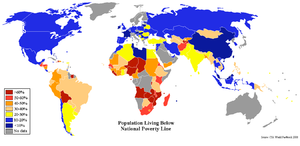
List of countries by percentage of population living in poverty
Encyclopedia
These are lists of countries of the world by percentage of population living in poverty
. "Poverty" defined as an economic condition of lacking both money
and basic necessities needed to successfully live, such as food
, water
, education
, healthcare, and shelter. There are many working definitions of "poverty," with considerable debate on how to best define the term. Lack of income security, economic stability and the predictability
of one's continued means to meet basic needs all serve as absolute indicators of poverty. Poverty may therefore also be defined as the economic condition of lacking predictable and stable means of meeting basic life needs.
Only countries for which sourced data is available are listed.
Poverty
Poverty is the lack of a certain amount of material possessions or money. Absolute poverty or destitution is inability to afford basic human needs, which commonly includes clean and fresh water, nutrition, health care, education, clothing and shelter. About 1.7 billion people are estimated to live...
. "Poverty" defined as an economic condition of lacking both money
Money
Money is any object or record that is generally accepted as payment for goods and services and repayment of debts in a given country or socio-economic context. The main functions of money are distinguished as: a medium of exchange; a unit of account; a store of value; and, occasionally in the past,...
and basic necessities needed to successfully live, such as food
Food
Food is any substance consumed to provide nutritional support for the body. It is usually of plant or animal origin, and contains essential nutrients, such as carbohydrates, fats, proteins, vitamins, or minerals...
, water
Water
Water is a chemical substance with the chemical formula H2O. A water molecule contains one oxygen and two hydrogen atoms connected by covalent bonds. Water is a liquid at ambient conditions, but it often co-exists on Earth with its solid state, ice, and gaseous state . Water also exists in a...
, education
Education
Education in its broadest, general sense is the means through which the aims and habits of a group of people lives on from one generation to the next. Generally, it occurs through any experience that has a formative effect on the way one thinks, feels, or acts...
, healthcare, and shelter. There are many working definitions of "poverty," with considerable debate on how to best define the term. Lack of income security, economic stability and the predictability
Predictability
Predictability is the degree to which a correct prediction or forecast of a system's state can be made either qualitatively or quantitatively.-Predictability and Causality:...
of one's continued means to meet basic needs all serve as absolute indicators of poverty. Poverty may therefore also be defined as the economic condition of lacking predictable and stable means of meeting basic life needs.
- The first table lists countries by the percentage of their population with an income of less than 1.25, and less than 2, US dollars per day. The sourced data refers to the most recent year available during the period 2000-2007.
- The second table lists countries by the percentage of the population living below the national poverty line — the poverty line deemed appropriate for a country by its authorities. National estimates are based on population-weighted subgroup estimates from household surveys. Definitions of the poverty line may vary considerably among nations. For example, rich nations generally employ more generous standards of poverty than poor nations. Thus, the numbers are not strictly comparable among countries.
Only countries for which sourced data is available are listed.
 |
| Population living under 1.25 and 2 dollar (PPP Purchasing power parity In economics, purchasing power parity is a condition between countries where an amount of money has the same purchasing power in different countries. The prices of the goods between the countries would only reflect the exchange rates... ) a day (%) (International poverty line) |
Population living below national poverty line (%) | ||||||||||||||||||||||||||||||||||||||||||||||||||||||||||||||||||||||||||||||||||||||||||||||||||||||||||||||||||||||||||||||||||||||||||||||||||||||||||||||||||||||||||||||||||||||||||||||||||||||||||||||||||||||||||||||||||||||||||||||||||||||||||||||||||||||||||||||||||||||||||||||||||||||||||||||||||||||||||||||||||||||||||||||||||||||||||||||||||||||||||||||||||||||||||||||||||||||||||||||||||||||||||||||||||||||||||||||||||||||||||||||||||||||||||||||||||||||||||||||||||||||||||||||||||||||||||||||||||||||||||||||||||||||||||||||||||||||||||||||||||||||||||||||||||||||||||||||||||||||||||||||||||||||||||||||||||||||||||||||||||||||||||||||||||||||||||||||||||||||||||||||||||||||||||||||||||||||||||||||||||||||||||||||||||||||||||||||||||||||||||||||||||||||||||||||||||||||||||||||||||||||||||||||||||||||||||||||||||||||||||||||||||||||||||||||||||||||||||||||||||||||||||||||||||||||||||||||||||||||||||||||||||||||||||||||||||||||||||||||||||||||||||||||||||||||||||||||||||||||
EWLINE
|
EWLINE
|
See also
- Economic inequalityEconomic inequalityEconomic inequality comprises all disparities in the distribution of economic assets and income. The term typically refers to inequality among individuals and groups within a society, but can also refer to inequality among countries. The issue of economic inequality is related to the ideas of...
- Income disparityIncome disparityThe gender pay gap is the difference between male and female earnings expressed as a percentage of male earnings, according to the OECD. The European Commission defines it as the average difference between men’s and women’s hourly earnings...
- International inequalityInternational inequalityInternational inequality is inequality between countries . Economic differences between rich and poor countries are considerable...
- Precaria (country)Precaria (country)Precaria is a concept suggested in the framework of the international campaign of the non governmental organisation Un techo para mi país, in English “A roof for my country “, that designates allegorically an imaginary country, which would be inhabited by all the poor people from Latin America, for...
External links
- Global Distribution of Poverty Global poverty datasets and map collection



































































































































































